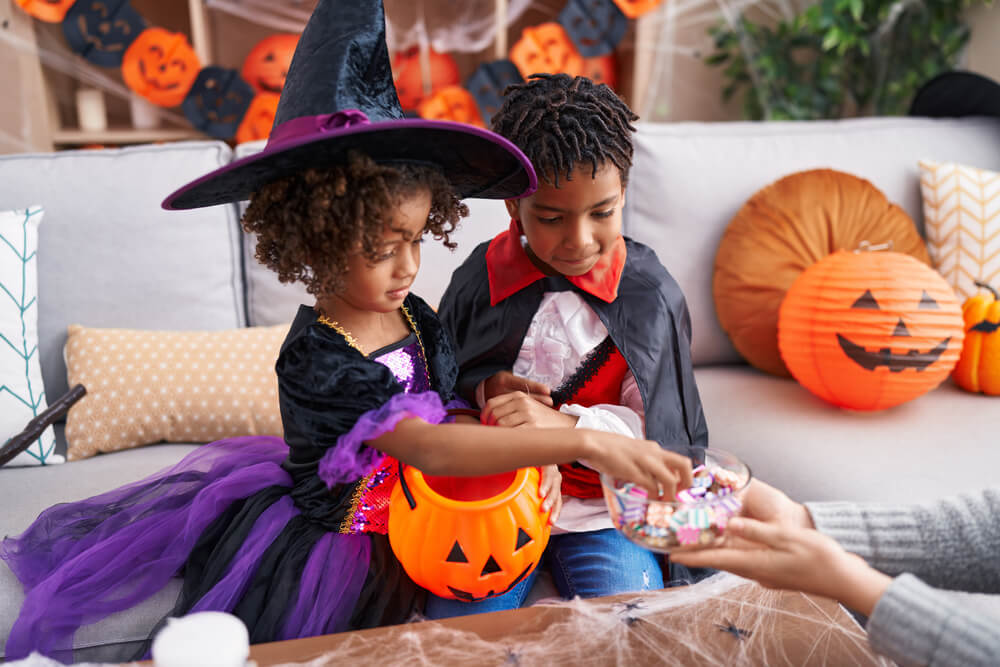Jack-o’-lanterns. Costumes. Candy. Kids running door to door shouting “Trick or Treat!” Halloween is a magical time. It gives children a chance to be imaginative and it helps to build their sense of community as they venture from home to home, collecting treats.
While Halloween is fun for many children, it can be stressful for others. The day can be overwhelming for those kids who have difficulties with communication, differences in sensory processing or who struggle with changes in routine. The unusual schedule, the loud sounds, the feel of the costumes and the scary decorations can be too much for some kids to take in, leading to tears and dysregulation.
These difficulties can also have a toll on parents. It would be tempting to just skip Halloween altogether. But this would deprive kids of a fun evening and the opportunity for the family to create wonderful memories.
So, what can parents do to minimize difficulties during Halloween? Here are five steps to ensure Halloween is an inclusive, positive experience for all.
- Talk to children in advance about what to expect.
Routine and predictability are essential for all children, but especially for those with anxiety and those who have difficulty anticipating schedule changes. Knowing in advance how the evening will unfold helps children plan and create a sense of calm.
Talk to your child about what is expected. If more structure is needed, telling stories, reading books and watching videos about Halloween can all help to start the conversation.
Using visual schedules and maps can also be useful to help the child know what to anticipate.
You can also plan your route and walk it together before Halloween night.
- Practice what to say.
For children with speech or language difficulties, having conversations or even saying ‘trick or treat’ can be stressful. Rehearse with your child what they will say and do on Halloween night. This will help make the evening feel more familiar and give them a clear script to use.
Practice can include role-playing (at home or with a neighbour) to rehearse what to say. If practice is still challenging, use an assistive communication device, like an iPad or prerecorded messages.
- Make the costume comfortable.
When choosing a costume, make sure in advance that it is comfortable. Remove tags and consider buying a size larger, allowing your child to wear another layer underneath. If the costume fabric has a distinctive smell, consider washing it before they wear it.
Have your child wear the costume a few times before Halloween to get used to how it feels. If a costume is too much, consider having them wear only accessories or going out as is.
- Know your child’s limits.
Not all kids are ready to do an entire night of trick or treating. Consider starting with only a few houses and adding more when they are ready. Also, look for signs that they may be tired, overly excited, grumpy or overwhelmed.
You can provide breaks or other supports, such as headphones or a preferred toy, in these moments.
Some children will be tired and ready to go home as the evening continues, while others might have difficulty ending the fun. To make it easier, consider making your trick-or-treating route a circle so you eventually get closer to home and can naturally end the activity.
Setting a timer or an alarm before going out can also help, as it can be a neutral signal to go home. For those who have a difficult time ending the fun, preparing a preferred activity for your child to do at home, may increase their motivation to wrap up trick-or-treating.
- Celebrate differently.
If, despite the preparations and practice, your child is still not comfortable with trick-or-treating, that is okay. There are many ways to celebrate Halloween. Do Halloween arts and crafts, bake or watch a movie instead.
Handing out candy is another excellent way to participate without leaving home. Lastly, check your community to see if there are alternatives to traditional trick-or-treating, like trunk-or-treat activities or a Halloween-themed scavenger hunt.
Halloween should be an exciting and happy activity for all kids. With some planning, parents can ensure that all children are included in the fun.
For more Halloween tips and activities, visit https://www.thelittleredplayhouse.com/.
Photo courtesy of DepositPhotos




